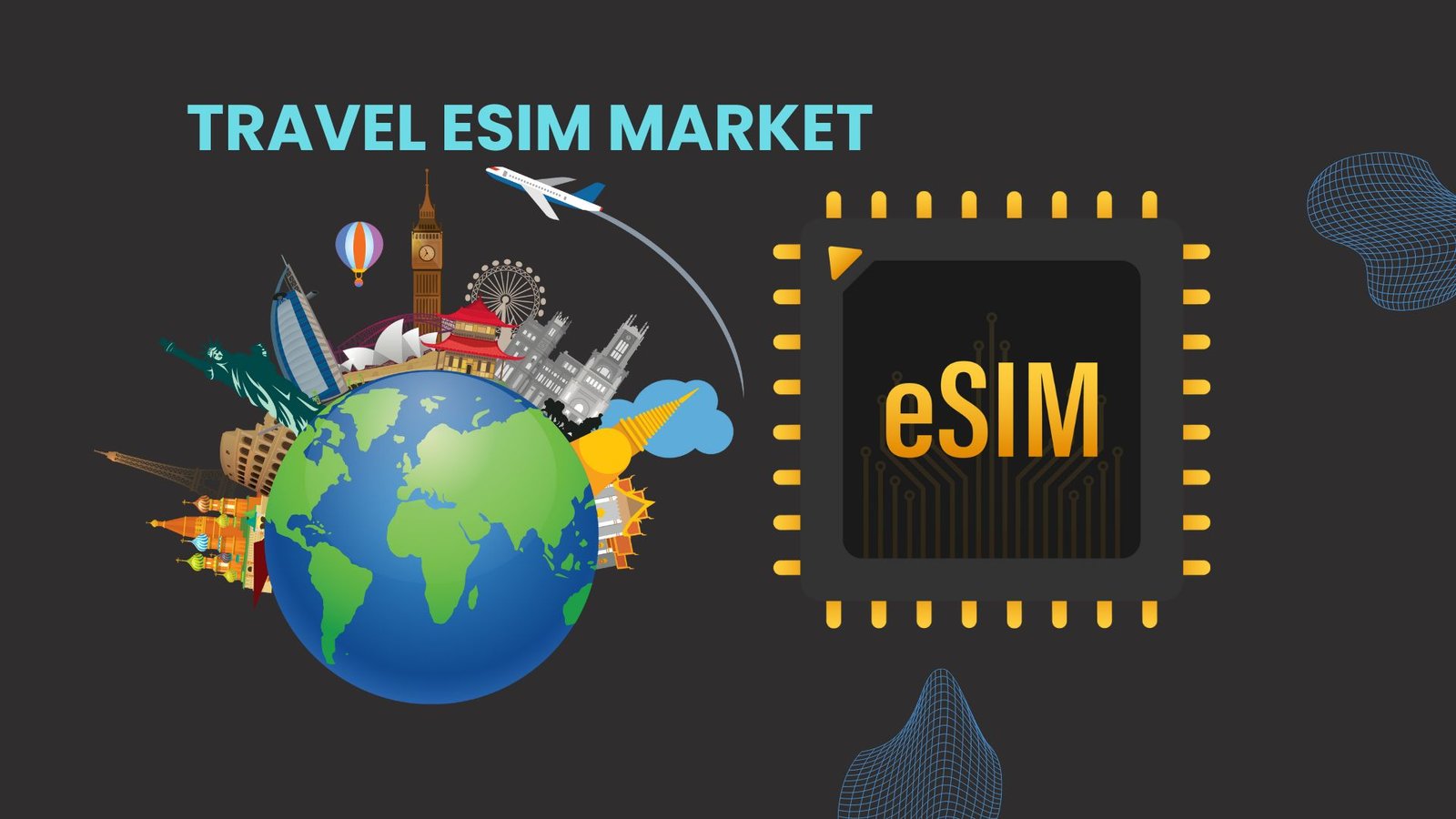Travel eSIM Market Projected to Surpass USD 2,60,735 Mn By 2034
Updated · Aug 29, 2025

WHAT WE HAVE ON THIS PAGE
Introduction
The Global Travel eSIM Market is undergoing exceptional expansion, growing from USD 2,030.8 Million in 2024 to an estimated USD 2,60,735 Million by 2034, at a remarkable CAGR of 62.50% between 2025 and 2034. In 2024, Asia-Pacific dominated the market, capturing over 56.7% of the share and generating about USD 1,151.4 Million in revenue. This leadership is supported by the region’s large base of international travelers, rapid digital adoption, and increasing smartphone penetration.
The Travel eSIM market refers to the growing industry centered around embedded SIM card technology designed specifically for travelers. Unlike traditional physical SIM cards, travel eSIMs are integrated digitally within devices, allowing users to activate telecom service plans remotely without swapping out physical cards. This shift offers users seamless and affordable mobile connectivity across borders, supporting global travelers’ need for cost-effective and convenient communication solutions during international trips.

The market has surged due to increasing global travel and the rise of digital nomads who demand uninterrupted and flexible internet access internationally. Top driving factors for this market include the rise in international tourism and business travel, which creates a strong demand for flexible and affordable mobile services. Traditional roaming services come with high costs and operational hassles, making travel eSIMs appealing for their instant activation and multi-network switching capabilities without physical SIM changes.
Additionally, growing smartphone penetration with eSIM-compatible devices enables more users to adopt this technology easily. Remote work and digital nomadism contribute significantly by requiring reliable, borderless connectivity. Telecom operators are also providing competitive data plans tailored to travelers, fueling market expansion.
One of the strongest adoption drivers is cost efficiency. In 2024, international subscribers paid an average of USD 8.56 per GB for roaming data, while those using travel eSIM packages spent only USD 5.51 per GB, a 35.1% saving. This pricing advantage, combined with the convenience of digital connectivity, positions travel eSIMs as an attractive alternative for global travelers seeking affordability and flexibility.
According to Kaleido Intelligence, retail spending in the travel eSIM segment is projected to hit USD 3.3 Billion by 2025, marking 165% growth compared to 2023. By 2028, travel eSIMs are expected to represent 28% of total travel connectivity spending, including roaming, traditional SIMs, and digital solutions. With the average spend per eSIM expected to stay under USD 15 and adoption growing nearly 50% annually over the next four years, the market is being driven by affordability, the rise of eSIM-enabled mid- and low-tier smartphones, and budget-friendly data plans, making eSIMs a mainstream solution for international travelers.
Key Takeaways Summary
- The market is projected to grow from USD 2,030.8 Million in 2024 to USD 2,60,735 Million by 2034, recording a CAGR of 62.50% between 2025 and 2034.
- In 2024, the Smartphones segment dominated with a 76.8% share, reflecting their widespread adoption in travel connectivity.
- The Individual Travelers segment led with a 61.9% share, showing strong preference for personal eSIM usage over enterprise deployments.
- Regionally, Asia-Pacific dominated with 56.7% share in 2024, generating USD 1,151.4 Million in revenue, supported by rapid mobile adoption and cross-border travel.
Regional Analysis
China’s leadership in the travel eSIM market is becoming increasingly clear, with the country recording a market value of USD 556.1 Million in 2024. This growth reflects the nation’s rapid adoption of digital connectivity solutions, supported by strong government focus on 5G expansion, widespread smartphone penetration, and consumer preference for seamless travel experiences. These factors are positioning China as one of the primary drivers of eSIM adoption within the Asia-Pacific region.

At the regional level, Asia-Pacific dominated the global Travel eSIM market in 2024, holding more than 56.7% of the share and generating nearly USD 1,47,836 Million in revenue. This dominance is attributed to the region’s advanced mobile infrastructure, high rates of mobile internet penetration, and the strong presence of technology providers offering innovative eSIM solutions. Together, these dynamics highlight Asia-Pacific’s central role in shaping the future of travel connectivity and further reinforce China’s pivotal contribution to this leadership.

Driver Factor
Increasing International Travel and Smartphone Use
One primary driving factor behind the growth of the Travel eSIM market is the rapidly increasing number of international travelers. As more people travel for business, tourism, and education, the need for reliable and cost-effective mobile connectivity while abroad has surged. Unlike traditional SIM cards that require physical swapping or expensive roaming charges, eSIM technology offers travelers the convenience of switching networks digitally without changing SIM cards. This seamless experience attracts travelers who want uninterrupted and affordable data access across borders.
Moreover, the widespread adoption of smartphones worldwide fuels the demand for Travel eSIMs. With over 90% of the global population using mobile phones, mostly smartphones, people rely heavily on mobile internet for navigation, communication, bookings, and social sharing during their trips. The growing number of eSIM-compatible devices further supports this demand, as consumers look for smarter, simpler connectivity solutions that can adapt to their travel needs without hassle or extra cost.
Restraint Factor
Limited Device Compatibility and Regulatory Challenges
A significant restraint in the Travel eSIM market is the limited compatibility of devices with eSIM technology. While eSIM adoption is gaining traction, not all smartphones and devices support eSIM functionality, especially older or lower-end models. This limits the potential user base because travelers with incompatible devices cannot benefit from eSIM convenience and may stick to traditional SIM cards. The uneven rollout of compatible devices across different regions also restricts broader market penetration.
In addition, regulatory challenges across countries pose another major hurdle. Different nations have unique rules concerning mobile telecommunications and data services including eSIM activation and usage restrictions. These regulatory inconsistencies create confusion, complicate market entry for providers, and sometimes restrict seamless cross-border use. Compliance with data privacy laws in several regions further adds to the operational complexity. Together, these factors slow down eSIM adoption, limiting its availability and consumer choice in certain parts of the world.
Opportunity Analysis
Integration with 5G and Expanding Digital Nomadism
The growing deployment of 5G networks worldwide presents an important opportunity for the Travel eSIM market. As mobile operators increase 5G coverage, demand for eSIM-enabled devices is expected to rise, since 5G offers faster and more reliable internet connectivity. This convergence of 5G and eSIM technologies will enhance user experiences by providing travelers with superior speeds and stable mobile access wherever they go. Providers can leverage this to develop enhanced travel data plans and premium services that attract tech-savvy global travelers.
Another opportunity lies in the rise of remote work and digital nomadism, which has increased the need for cross-border, flexible connectivity solutions. As more people work while traveling internationally, they require uninterrupted, easily manageable mobile internet access. eSIMs cater perfectly to this trend by allowing network switching without physical SIM swaps. This expanding customer segment offers an ongoing growth avenue, encouraging telecom companies to create tailored offerings and form strategic partnerships with travel platforms and device manufacturers to tap into this evolving market.
Challenge Analysis
Activation Complexity and Data Security Concerns
Despite the many advantages, the Travel eSIM market faces noteworthy challenges around the activation and management process. For users unfamiliar with the technology, setting up an eSIM and switching networks digitally can be confusing and complicated compared to inserting a physical SIM card. This complexity may discourage less tech-savvy travelers from adopting eSIM solutions, slowing market growth. Additionally, inconsistent activation procedures from different mobile operators can add to the frustration, reducing user satisfaction and adoption rates.
Security and privacy concerns also present critical challenges. Since eSIM profiles are stored and managed digitally, they are potentially vulnerable to hacking or unauthorized access. Travelers may worry about the safety of their personal data when using eSIM networks, especially across various countries with different cybersecurity standards. These risks necessitate strong encryption, secure authentication methods, and transparent data protection policies by providers to build consumer trust and facilitate wider acceptance of travel eSIMs.
Key Trends
- Rising adoption of eSIM-capable smartphones and devices worldwide, including wearables and tablets.
- App-based eSIM management platforms enabling easy purchase and activation of regional/global data plans.
- Partnerships among device manufacturers, mobile virtual network operators, and travel companies enhancing service offerings.
- Increasing remote work and digital nomadism boosting demand for borderless, reliable mobile connectivity.
- Growing consumer preference for flexible, affordable roaming alternatives and multi-country data bundles.
Growth Drivers:
- High mobile penetration and increasing international tourism and business travel.
- Cost benefits: Travel eSIM users pay significantly less for data (e.g., $5.51 per GB) than traditional roaming users ($8.56 per GB), creating a strong value proposition.
- Governments supporting eSIM adoption to promote connectivity and reduce environmental waste from traditional SIM cards.
- Rising smartphone penetration (exceeding 85% globally as of 2026) facilitating wider eSIM use.
- Strategic collaborations expanding market reach and service integration.
Key Market Segments
By Device Type
- Smartphones
- Tablets & Laptops
- Wearables
- Others
By End-User
- Individual Travelers
- Business Travelers
Key Regions and Countries
- North America
- US
- Canada
- Europe
- Germany
- France
- The UK
- Spain
- Italy
- Rest of Europe
- Asia Pacific
- China
- Japan
- South Korea
- India
- Australia
- Singapore
- Rest of Asia Pacific
- Latin America
- Brazil
- Mexico
- Rest of Latin America
- Middle East & Africa
- South Africa
- Saudi Arabia
- UAE
- Rest of MEA
Top Key Players in the Market
- Numero eSIM
- Redtea Mobile
- SimCorner
- GigSky
- GlobaleSIM
- TravelSIM
- Ubigi
- aloSIM
- Nomad
- Simify
- Maya Mobile
- Airalo
- Holafly
- BNESIM
- Drimsim
- Orange
- Simly
- Yesim
- Other Key Players
Conclusion
The Travel eSIM Market is undergoing a structural transformation driven by the convergence of global mobility needs, digital-first user behavior, and advancements in remote provisioning technology. The increasing awareness among international travelers about the advantages of eSIMs, including cost savings and seamless activation, has created a favorable environment for adoption. With over 35% cost savings compared to traditional roaming and rising eSIM-compatible device penetration, the foundation for mass adoption has already been established.
However, the market’s expansion remains contingent on several critical factors. These include the global harmonization of regulatory frameworks, increased support from mobile network operators, and improved consumer education about how to provision and manage eSIM profiles effectively. Addressing these gaps will be vital for unlocking the full economic and operational potential of this technology.
Sources

Rohan is a senior editor at Techno Trenz. He knows a lot about digital marketing, SEO, and social media optimization. Rohan is great at creating and editing detailed articles with accurate statistics that readers find useful. As a senior editor, he reviews and checks the quality of content from many writers before it is published. He also makes infographics to go with the statistics, making the information easier to understand and more engaging. Rohan's hard work ensures that Techno Trenz provides high-quality and informative content to its readers.










